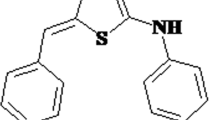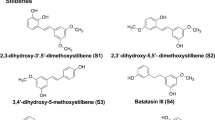Abstract
The need for beneficial use of sedatives in oncologic patients is increasing. Therefore, in this study, antiproliferative characteristics of herbal and synthetic sedatives were examined in vitro in SNU-C4 human colorectal adenocarcinoma cells. Apigenin (50% inhibition concentration, IC50 = 1.8 ± 0.5 μM) and diazepam (IC50 = 7.0 ± 0.5 μM) showed concentration-dependent inhibition of SNU-C4 cancer cell survival. Efficacy of cancer cell survival inhibition by apigenin and diazepam was much lower than that of 5-fluorouracil (5-FU), a known chemotherapeutic drug. However, 10−6 M concentration of apigenin and diazepam potentiated 5-FU-induced cytotoxicity. In SNU-C4 cells, 10−6 M concentrations of diazepam, flumazenil (Ro15-1788), Ro5-4864, or PK11195, all ligands for central- or peripheral-type benzodiazepine (BZD) receptors, inhibited cell survival like the flavonoid apigenin (4′,5,7-trihydroxyflavone) and fisetin (3,7,3′,4′-tetrahydroxyflavone). Also like the plant flavonoids, treatment with 10−6 M concentration of diazepam for 3 days hardly affect the peripheral-type BZD receptor (PBR) messenger RNA (mRNA) expression and inhibited glucose utilization of SNU-C4 cells. Treatment with flavonoids or diazepam for 6 days upregulated PBR mRNA expression and cell cytotoxicity of SNU-C4 cells. Furthermore, treatment with 10−6 M concentration of apigenin, a natural sedative material originating from traditional herbs, positively modulated BZD-induced antiproliferative cytotoxicity in SNU-C4 cells. Overall, the in vitro antiproliferative activity on SNU-C4 cancer cells of herbal sedatives, such as apigenin, plus additive enhancement of synthetic BZD- and 5-FU-induced antiproliferative activities, were shown. In conclusion, this study provides experimental basis for advanced trial in the future.





Similar content being viewed by others
References
Lavicka J, Sarissky M, Mirossay A, Sulla I, Mojzis J, Mirossay L (2002) Diazepam enhances etoposide-induced cytotoxicity in U-87 MG human glioma cell line. Fundam Clin Pharmacol 15:201–207
Sarissky M, Lavicka J, Kocanova S, Sulla I, Mirossay A, Miskovsky P, Gajdos M, Mojzis J, Mirossay L (2005) Diazepam enhances hypericin-induced photocytotoxicity and apoptosis in human glioblastoma cells. Neoplasma 52(4):352–359
Oudard S, Carpenter A, Banu E, Fauchon F, Celerier D, Poupon MF, Dutrillaux B, Andrieu JM, Delattre JY (2003) Phase II study of ionidamine and diazepam in the treatment of recurrent glioblastoma multiforme. J Neurooncol 63(1):81–86
Boitano A, Ellman JA, Glick GD, Opipari AJ (2003) The proapoptotic benzodiazepine Bz-423 affects the growth and survival of malignant B cells. Cancer Res 63:6870–6876
Kim DH, Lee JT, Lee IK, Ha JH (2008) Comparative anticancer effects of flavonoids and diazepam in cultured cancer cells. Biol Pharm Bull 31(2):255–259
Zhuang H, Hustinx R, Alavi A (2006) Effect of diazepam on the efficacy of dual-phase FDG PET imaging. Eur J Nucl Med Mol Imaging 33:228–229
Xu Z, Wang F, Tsang SY, Ho KH, Zheng H, Yuen CT, Chow CY, Xue H (2006) Anxiolytic-like effect of baicalin and its additivity with other anxiolytics. Planta Med 72(2):189–192
Loscalzo LM, Wasowski C, Paladini AC, Marder M (2008) Opioid receptors are involved in the sedative and antinociceptive effects of hesperidin as well as in its potentiation with benzodiazepines. Eur J Pharmacol 580(3):306–313
Masser K, Hopfner M, Jansen A, Weisunger G, Gavish M, Kozikowski AP, Weizman A, Carayon P, Riecken EO, Zeitz M, Scherubi H (2001) Mechanisms of mitochondrial apoptosis induced by peripheral benzodiazepine receptor ligands in human colorectal cancer cells. Br J Cancer 85(11):1771–1780
Clingen PH, De Silva IU, McHugh PJ, Ghadessy FJ, Tilby MJ, Thurston DE, Hartley JA (2005) The XPF-ERCC1 endonuclease and homologous recombination contribute to the repair of minor groove DNA interstrand crosslinks in mammalian cells produced by the pyrrolo [2, 1-c][1, 4]benzodiazepine dimer SJG-136. Nucleic Acids Res 33(10):3283–3291
Ha JH, Lee JT, Cho IH, Chun KA, Park GE, Choi HC, Lee KY, Kim SH, Suk K, Kim IK, Lee MG (2007) Upregulation of PBR mRNA expression in human neuroblastoma cells by flavonoids. Phytomedicine 14(2–3):232–235
Younes M, Brown RW, Mody DR, Fernandez I, Laucirica R (1995) GLUT1 expression in human breast carcinoma: correlation with known prognostic markers. Anticancer Res 15:2895–2898
Binder C, Binder L, Marx D, Schauer A, Hiddemann W (1997) Deregulated simultaneous expression of multiple glucose transporter isoforms in malignant cells and tissues. Anticancer Res 17:4299–4304
Harmon AW, Patel YM (2004) Naringenin inhibits glucose uptake in MCF-7 breast cancer cells: a mechanism for impaired cellular proliferation. Breast Cancer Res 85:103–110
Kuo PC, Liu HF, Chao JL (2004) Survivin and p53 modulate quercetin-induced cell growth inhibition and apoptosis in human lung carcinoma cells. J Biol Chem 279(53):55875–55885
Brusselmans K, Vrolik R, Verhoeven G, Swinnen JV (2005) Induction of cancer cell apoptosis by flavonoids is associated with their ability to inhibit fatty acid synthase activity. J Biol Chem 280(7):5636–5645
Miocinovic R, McCabe NP, Keck RW, Jankun J, Hampton JA, Selman SH (2005) In vivo and in vitro effect of baicalein on human prostate cancer cells. Isolation & identification of 6-methylapigenin, a competitive ligand for the brain GABA(A) receptors, from Valeriana Wallichii. Int J Oncol 26(1):241–246
Marder M, Paladini AC (2002) GABA (A)-receptor ligands of flavonoid structure. Curr Top Med Chem 2(8):853–867
Wasoski C, Marder M, Viola H, Medina JH, Paladini AC (2002) Isolation & identification of 6-methylapigenin, a competitive ligand for the brain GABA(A) receptors, from Valeriana Wallichii. Planta Med 68:934–936
Fernandez SP, Wasoski C, Loscalzo LM, Granger RE, Johnston GAR, Paladini AC, Marder M (2006) Central nervous system depressant action of flavonoid glycosides. Eur J Pharm 539:168–176
Ognibene E, Bovicelli P, Adriani W, Saso L, Laviola G (2008) Behavioral effects of 6-bromoflavanone and 5-methoxy-6, 8-dibromoflavanone as anxiolytic compounds. Prog Neuropsychopharmacol Biol Psychiatry 32(1):128–134
Mizoguchi K, Yuzurihara M, Ishige A, Sasaki H, Tabira T (2002) Saiko-ka-ryudotsu-borei-to, an herbal medicine, prevents chronic stress-induced disruption of glucocorticoid negative feedback in rats. Life Sci 72:67–77
Mizoguchi K, Ikeda R, Shoji H, Tanaka Y, Jin X-L, Kase Y, Takeda S, Maruyama W, Tabira T (2008) Saiko-ka-ryudotsu-borei-to, a herbal medicine, prevents chronic stress-induced anxiety in rats:comparision with diazepam. J Nat Med [Epub ahead of print]
Fresco P, Borges F, Diniz C, Marques MP (2006) New insights on the anticancer properties of dietary polyphenols. Med Res Rev 26(6):747–766
Kale A, Gawande S, Kotwal S (2008) Cancer phytotherapeutics: role for flavonoids at the cellular level. Phytother Res 22(5):567–577
Cardenas M, Marder M, Blank VC, Roguin LP (2006) Antitumor activity of some natural flavonoids and synthetic derivatives on various human and murine cancer cell lines. Biol Med Chem 14:2966–2971
Acknowledgments
This work was supported by BioMedical Research Institute grant, Kyungpook National University Hospital (2005).
Author information
Authors and Affiliations
Corresponding author
Rights and permissions
About this article
Cite this article
Lee, SW., Lee, JT., Lee, MG. et al. In vitro antiproliferative characteristics of flavonoids and diazepam on SNU-C4 colorectal adenocarcinoma cells. J Nat Med 63, 124–129 (2009). https://doi.org/10.1007/s11418-008-0300-x
Received:
Accepted:
Published:
Issue Date:
DOI: https://doi.org/10.1007/s11418-008-0300-x




